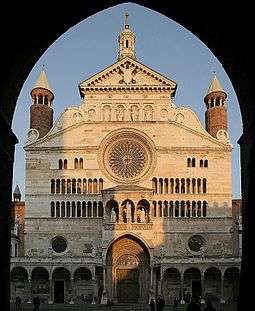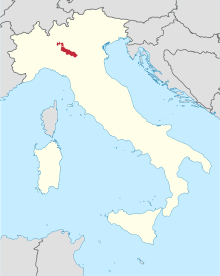Roman Catholic Diocese of Cremona
| Diocese of Cremona Dioecesis Cremonensis | |
|---|---|
 | |
| Location | |
| Country | Italy |
| Ecclesiastical province | Milan |
| Statistics | |
| Area | 1,917 km2 (740 sq mi) |
| Population - Total - Catholics |
(as of 2013) 368,797 331,250 (est.) (89.8%) |
| Parishes | 224 |
| Information | |
| Denomination | Catholic Church |
| Rite | Roman Rite |
| Established | 4th century |
| Cathedral | Cattedrale di S. Maria Assunta |
| Secular priests |
308 (diocesan) 28 (Religious Orders) |
| Current leadership | |
| Pope | Francis |
| Bishop | Antonio Napolioni |
| Emeritus Bishops | Dante Lafranconi |
| Map | |
 | |
| Website | |
| www.diocesidicremona.it | |
The Diocese of Cremona (Latin: Dioecesis Cremonensis) is a Roman Catholic ecclesiastical territory in northern Italy, a suffragan of the Archdiocese of Milan.[1][2] Its see is the Cremona Cathedral.
History
Cremona is in Lombardy, Italy, on the left bank of the River Po. It was built by the Cenomanni Gauls, but later became a Roman colony and a frontier fortress.
About 600 Cremona, until then a part of the Byzantine Emperor, was captured by the Lombard king, Agilulf. Under the Emperor Otto I and his successors, its bishops acquired temporal sovereignty, but in 900 the people expelled Bishop Olderico and adopted a republican form of government.
The Emperor Henry IV (1056–1106), however, confirmed Bishop Landulf in all imperial grants made to his predecessors. On the other hand Emperor Henry V (1106–25) restored to the people their communal rights. Thenceforth Cremona became a citadel of Ghibellinism and was greatly favoured by Frederic Barbarossa and Emperor Frederick II, though for the same reason frequently at war with the neighbouring cities. In later medieval times it had many lords or "tyrants", the Pallavicini, the Bovara, the Cavalcabo, the Visconti, the Sforza, until it became part of the Duchy of Milan (1328). In 1702 it was taken by imperial troops, and in 1796 and 1800 fell into the hands of the French.
The people of Cremona venerate St. Sabinus as their first missionary and first bishop; he is said to have lived in the 1st century of our era. Among the better-known early bishops are St. Syrinus (c. 340), a valiant apologist of the Faith against the Arians, and St. Silvinus (733); the latter is held in great veneration. Liudprand of Cremona was sent (946) as ambassador to Constantinople by the Emperor Otto II, and is the most famous historical writer of the 10th century.
Other important bishops were Gualtiero (1096), in whose time the cathedral was begun; Sicardo (1185), author of a chronicle; Cacciaconte da Somma (1261), under whom was erected the belfry of the cathedral; Niccolo Sfondrati (1560), later Pope Gregory XIV; his nephew Paolo (1607); also the zealous and charitable Omobono di Offredi (1791).
Bishops
- Pietro Grassi (1401–1402 Appointed, Bishop of Pavia)
- ...
- Costanzo Fondulo (1412–1423 Resigned)
- ...
- Giovanni Stefano Botticelli (1466–1472 Died)
- Jacopo-Antonio dalla Torre (1476–1486 Died)
- Ascanio Maria Sforza (1486–1505 Died)
- Galeotto Franciotti della Rovere (1505–1507 Resigned)
- Benedetto de Accolti (1523–1524 Appointed, Archbishop of Ravenna)
- Pietro de Accolti de Aretio (1524–1528 Resigned)
- ...
- Francesco Sfondrati (1549–1550 Died)
- Federico Cesi (1551–1560 Resigned)
- Niccolò Sfondrati (1560–1590 Elected, Pope of Rome)
- Cesare Speciano (Speciani) (1591–1607 Died)
- Paolo Emilio Sfondrati (1607–1610 Resigned)
- Giambattista Brivio (1610–1621 Died)
- Pietro Campori (1621–1643 Died)
- Francesco Visconti (1643–1670 Resigned)
- Pietro Isimbardi, O. Carm. (1670–1675 Died)
- Agostino Isimbardi, O.S.B. (1676–1681 Died)
- Lodovico Septala (1682–1697 Died)
- Alessandro Croce (1697–1704 Died)
- Carlo Ottaviano Guasco (1704–1717 Died)
- Alessandro Maria Litta (1718–1749 Resigned)
- Ignazio Maria Fraganeschi (1749–1790 Died)
- Omobono Offredi (1791–1829 Died)
- Carlo Emmanuelle Sardagna de Hohenstein (1831–1837 Resigned)
- Bartolomeo Casati (1839–1844 Died)
- Bartolomeo Carlo Romilli (1846–1847 Confirmed, Archbishop of Milan)
- Antonio Novasconi (1850–1867 Died)
- Geremia Bonomelli (1871–1914 Died)
- Giovanni Cazzani (1914–1952 Died)
- Danio Bolognini (1952–1972 Died)
- Giuseppe Amari (1973–1978 Appointed, Bishop of Verona)
- Fiorino Tagliaferri (1978–1983 Resigned)
- Enrico Assi (1983–1992 Died)
- Giulio Nicolini (1993–2001 Died)
- Dante Lafranconi (2001–2015 Retired)
- Antonio Napolioni (2015 Appointed–)
Parishes
The diocese has 223 parishes, all located within the region of Lombardy. The great majority (174) of these fall within the Province of Cremona. There are 28 in the Province of Mantua, 17 in the Province of Bergamo, and 4 in the Province of Milan.[3]
See also
- List of bishops of Cremona (in Italian)
- Timeline of Cremona
Notes
- ↑ Cheney, David M. "Diocese of Cremona". Catholic-Hierarchy.org. Retrieved June 16, 2018. [self-published]
- ↑ Chow, Gabriel. "Diocese of Cremona (Italy)". GCatholic.org. Retrieved June 16, 2018. [self-published]
- ↑ Source for parishes: CCI (2008), Parrocchie, Chiesa Cattolica Italiana, archived from the original on 2008-03-10, retrieved 2008-03-15 .
Sources
- Dragoni, Antonio (1840). Sulla storia ecclesiastica Cremonese nei primi tre secoli del Cristianesimo Discorsi o disquisizioni critiche (in Italian). Cremona: Giuseppe Feraboli.
- Sanclemente, Enrico (1814). Series critico-chronologica episcoporum Cremonensium (in Italian). Cremona: J. Feraboli.
External links
![]()